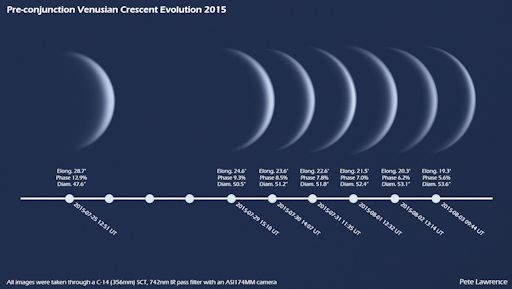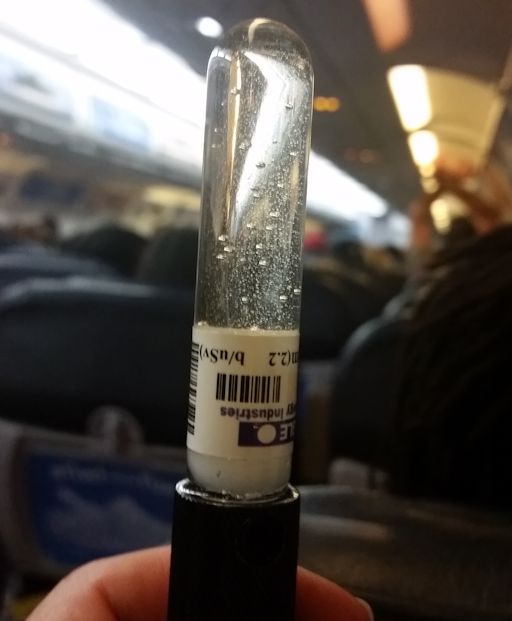Come to Tromsø and share Marianne's passion for rural photography: Chasethelighttours.co.uk invites you to experience "Heaven on Earth" with an aurora, fjord, fishing, whale watching, photography or sightseeing tour. | | |
CO-ROTATING INTERACTION REGION: NOAA forecasters estimate a 40% chance of polar geomagnetic storms on Aug. 6th when a co-rotating interaction region (CIR) is expected to hit Earth's magnetic field. CIRs are transition zones between fast- and slow-moving solar wind streams. Solar wind plasma piles up in these regions, producing density gradients and shock waves that do a good job of sparking auroras. Aurora alerts: text or voice.
INFERIOR CONJUNCTION OF VENUS: On August 15th, Venus will pass almost directly between Earth and the sun--an event astronomers call "inferior solar conjunction." As Venus approaches the sun, the planet is turning its night side toward Earth, reducing its luminous glow to a thin sliver. Astrophotographer Pete Lawrence of Selsey, UK, has been monitoring the transformation:

"A reasonably run of clear days in the UK has given me the opportunity to capture the Venusian crescent from 25 July to August 3rd, with July 26, 27 and 28 missing due to poor weather," explains Lawrence. "The progression of the crescent as Venus approaches inferior conjunction is clear."
In the days ahead, the crescent of Venus will become increasingly thin and circular. The horns of the crescent might actually touch when the Venus-sun angle is least on August 15th. This is arguably the most beautiful time to observe Venus--but also the most perilous. The glare of the nearby sun magnified by a telescope can damage the eyes of anyone looking through the eyepiece.
Anthony J. Cook of the Griffith Observatory has some advice for observers: "I have observed Venus at conjunction, but only from within the shadow of a building, or by adding a mask to the front end of the telescope to fully shadow the optics from direct sunlight. This is tricky with a refractor or a catadioptric, because the optics start at the front end of the tube. Here at Griffith Observatory, I rotate the telescope dome to make sure the lens of the telescope is shaded from direct sunlight, even through it means that the lens will be partially blocked when aimed at Venus. With our Newtonian telescope, I add a curved cardboard mask at the front end of the tube to shadow the primary mirror."
For the rest of this week Venus can still be observed without elaborate precautions in deep twilight after sunset. Every evening the crescent grows and narrows. Scan the realtime photo gallery for updates.
Realtime Venus Photo Gallery
NEUTRONS ON A PLANE: Want to experience space weather? It's easy. Just step onboard an airplane. Recently, Spaceweather.com and the students of Earth to Sky Calculus have been monitoring cosmic radiation levels in the cabins of commercial jets. Measurements of X-rays and gamma-rays show that travelers absorb the equivalent of one or more dental X-rays on a typical flight across the USA. But X-rays and gamma-rays represent only a fraction of the total radiation evnvironment. On July 23, 2015, for the first time, they carried a neutron bubble chamber onboard. Here is what the chamber looked like at the end of a 5 hour flight from Boston to Las Vegas:

Each of the bubbles is formed by an energetic neutron passing through the chamber. By counting the bubbles, it is possible to estimate the total dose of neutron radiation. The answer, for this particular flight, was 1240 microRads (energy range 200 keV - 15 MeV). How does this compare to ionizing radiation? X-ray and gamma-ray sensors carried onboard the same plane accumulated a lesser dose of 860 microRads (energy range 10 keV to 20 MeV).
Lesson: When characterizing the radiation environment inside an airplane, neutrons are at least as important as X-rays and gamma-rays.
Among researchers it is well known that neutrons are an important form of cosmic rays, providing much of the biologically effective radiation dose at altitudes of interest to aviation and space tourism. Low-energy neutrons also cause single-event upsets in aircraft avionics, especially devices that contain Boron 10.
During the five hours of the July 23rd flight, the radiation sensors accumulated a total dose of 2100 microRads (neutrons + X-rays + gamma-rays). This is ~140 times the dose of cosmic rays at sea level during the same 5 hours.
Realtime Space Weather Photo Gallery
Realtime Aurora Photo Gallery
Realtime Sprite Photo Gallery
Realtime NLC Photo Gallery
Every night, a network of NASA all-sky cameras scans the skies above the United States for meteoritic fireballs. Automated software maintained by NASA's Meteoroid Environment Office calculates their orbits, velocity, penetration depth in Earth's atmosphere and many other characteristics. Daily results are presented here on Spaceweather.com.
On Aug. 4, 2015, the network reported 75 fireballs.
(41 sporadics, 23 Perseids, 6 Southern delta Aquariids, 5 alpha Capricornids)

In this diagram of the inner solar system, all of the fireball orbits intersect at a single point--Earth. The orbits are color-coded by velocity, from slow (red) to fast (blue). [Larger image] [movies]
Potentially Hazardous Asteroids (
PHAs) are space rocks larger than approximately 100m that can come closer to Earth than 0.05 AU. None of the known PHAs is on a collision course with our planet, although astronomers are finding
new ones all the time.
On August 4, 2015 there were potentially hazardous asteroids.
Notes: LD means "Lunar Distance." 1 LD = 384,401 km, the distance between Earth and the Moon. 1 LD also equals 0.00256 AU. MAG is the visual magnitude of the asteroid on the date of closest approach. | | The official U.S. government space weather bureau |
| | The first place to look for information about sundogs, pillars, rainbows and related phenomena. |
| | Researchers call it a "Hubble for the sun." SDO is the most advanced solar observatory ever. |
| | 3D views of the sun from NASA's Solar and Terrestrial Relations Observatory |
| | Realtime and archival images of the Sun from SOHO. |
| | from the NOAA Space Environment Center |
| | the underlying science of space weather |
| | Web-based high school science course with free enrollment |

